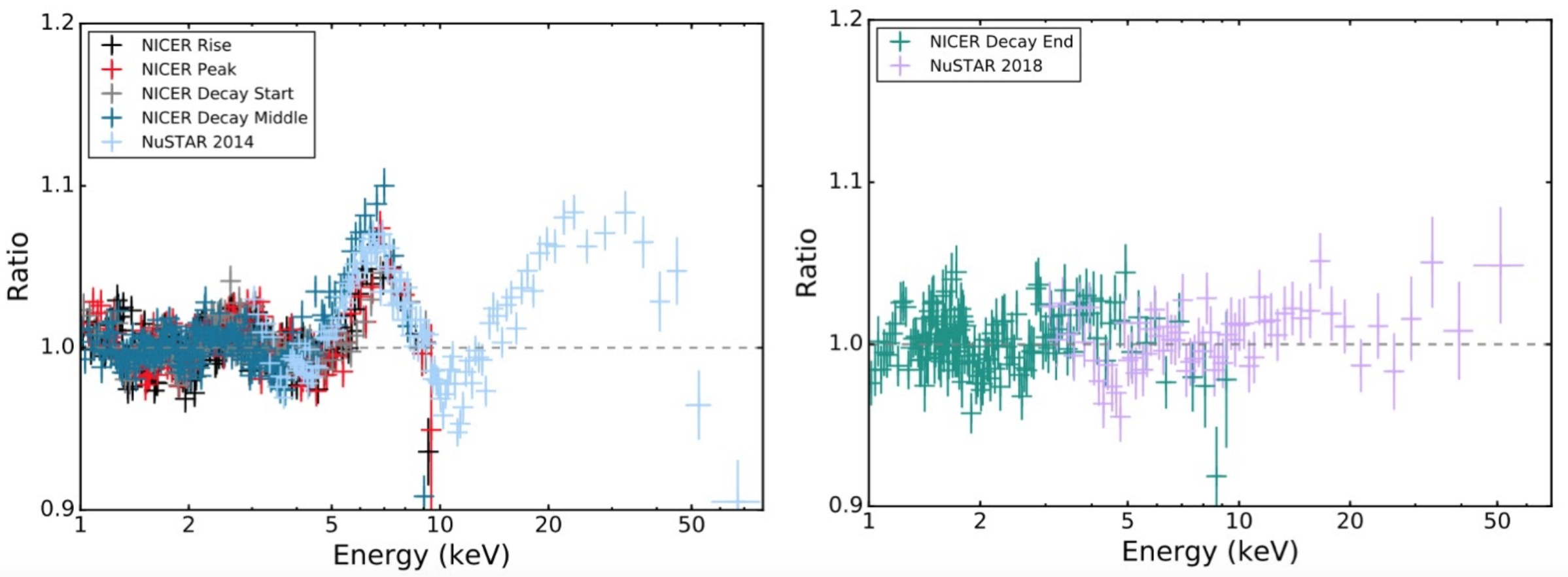NICER / ISS Science Nugget
for February 20, 2020
Modeling "reflected" X-rays in NICER data for Low Mass X-ray
Binaries
Low-mass X-ray binaries (LMXBs), in which a neutron star or a black hole
attracts gas from a low-mass companion star, are key tools for the study
of the physics of accretion. Their X-ray luminosity scales with the rate
at which matter is accreted by the compact object. The population of
transient sources alternates outbursts of accretion with quiescent
episodes and can therefore be studied over a wide range of X-ray
luminosities, from the Eddington limit (LEdd, at which radiation
pressure balances the pressure of the accreting matter) down to a very
small fraction of it. It is well known that at high X-ray luminosities
(> 1% LEdd), the accreted gas spirals in a thin disk that typically
extends close to the compact object. At very low accretion rates (∼
0.01% LEdd), on the other hand, the accretion disk is likely truncated
further away from the black hole or the neutron star. Nevertheless, it
is currently unclear at what accretion luminosity the disk begins to
move away, how this truncation proceeds with changing luminosity, and if
this process differs for neutron stars and black holes. Standard
accretion theory suggests that with decreasing accretion rates, a large
part of the inner disk evaporates into a radiatively inefficient hot
flow. In neutron star LMXBs, a second mechanism that can lead to disk
truncation may be at play: the stellar magnetic field may push the inner
disk out, but the interaction between the accretion disk and the
magnetosphere, while clearly important, remains poorly understood.
X-ray reflection modeling is a powerful tool for constraining the
geometry of accretion flows in LMXBs. This X-ray emission – originating
from close to the accretor and then reprocessed or "reflected" toward
the observer by the accretion disk – manifests most prominently as an
ionized iron emission line (Figure 1) at 6‒7 keV and a "Compton hump" at
20‒40 keV. The shape of these features is modified by Doppler and
gravitational redshift effects as the gas in the disk moves in
high-velocity orbits inside the gravitational well of the compact
accretor. The reflection spectrum thus encodes information about the
morphology of the accretion flow. Comparing the reflection spectrum at
different fractions of the Eddington accretion rate in the same source
can reveal changes in the accretion flow structure and properties as the
X-ray luminosity decays.

Figure 1:
NICER count-rate lightcurve of the 2018 outburst of 4U 1608‒52 (0.5‒6.8
keV, binned by 128 s exposure per point). The dashed red lines indicate
the different phases of the outburst for which we extracted the X-ray
spectra shown in the next Figure.

Figure 2:
NICER data obtained during different epochs of the 2018 outburst,
compared to data from NASA's NuSTAR hard-X-ray telescope obtained during
the 2014 outburst. Left: This plot illustrates that an ionized iron line
profile is clearly seen (around 6 keV energy) during the main part of
the 2018 outburst, similar to that seen in 2014. Right: Comparison of
NICER data obtained at the end of the decay of the 2018 outburst with
the NuSTAR observation taken around the same time. This plot illustrates
the sudden disappearance of the iron line in the NICER spectrum.
NICER observed the 2018 accretion outburst of the neutron star LMXB 4U
1608–52, to study changes in the reflection spectrum. A team led by
Univ. of Amsterdam graduate student Jakob van den Eijnden finds that the
broad iron line, clearly seen during the peak of the outburst when the
X-ray luminosity is high (5% LEdd), disappear during the decay of the
outburst when the source luminosity drops to ∼0.2% LEdd. They show
that this non-detection of the reflection features cannot be explained
by the lower signal-to-noise at lower flux, but is instead caused by
physical changes in the accretion flow, in a manner consistent with the
inner flow evaporating from a thin disk into a geometrically thicker
configuration, such as the theoretically expected formation of a
radiatively inefficient hot flow at low mass-accretion rates.
This work was recently accepted for publication by the British journal
Monthly Notices of the Royal Astronomical Society.
<< Previous
Main Index
Next >>